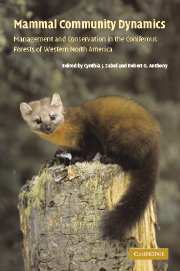 Mammal Community Dynamics
Mammal Community Dynamics Published online by Cambridge University Press: 15 December 2009
Mammals are prominent features of the landscape in coniferous forests of western North America. Large herbivores such as deer, elk, moose, and caribou are particularly noticeable. Smaller, though no less conspicuous, mammals include diurnal ground squirrels, marmots, pikas, and numerous species of chipmunks, and nocturnal bats. Overall, the mammalian faunas of western coniferous forests are rich and varied. Knowledge of their taxonomic makeup and biogeography provides a foundation for understanding current patterns of distribution, habitat use, and management. An examination of the distribution and diversity patterns of coniferous-forest species, together with an assessment of the factors influencing these patterns, forms the basis for this review.
Faunal composition
Nearly half (194) of approximately 400 species of mammals occurring in North America north of Mexico occupy western coniferous forests and associated meadow, brush, or riparian habitats (Table 3.1, Appendix). Eight orders and 27 families of mammals are represented. Per unit area, western North America has a much higher species richness than other temperate or boreal areas of the continent. This difference is readily discernible when comparing western and eastern coniferous forests (Hallett et al. 2003). Chipmunks (Tamias spp.) constitute a striking example: 21 species of chipmunks occupy western coniferous forests; there is only one (Tamias striatus) in eastern forests. Similar, though less dramatic examples, occur among shrews (Sorex spp.), bats (Myotis spp.), ground squirrels (Spermophilus spp., Marmota spp.), and other rodents (e.g., Peromyscus spp.).
The list of species (Table 3.1, Appendix) is somewhat loosely drawn.
To save this book to your Kindle, first ensure [email protected] is added to your Approved Personal Document E-mail List under your Personal Document Settings on the Manage Your Content and Devices page of your Amazon account. Then enter the ‘name’ part of your Kindle email address below. Find out more about saving to your Kindle.
Note you can select to save to either the @free.kindle.com or @kindle.com variations. ‘@free.kindle.com’ emails are free but can only be saved to your device when it is connected to wi-fi. ‘@kindle.com’ emails can be delivered even when you are not connected to wi-fi, but note that service fees apply.
Find out more about the Kindle Personal Document Service.
To save content items to your account, please confirm that you agree to abide by our usage policies. If this is the first time you use this feature, you will be asked to authorise Cambridge Core to connect with your account. Find out more about saving content to Dropbox.
To save content items to your account, please confirm that you agree to abide by our usage policies. If this is the first time you use this feature, you will be asked to authorise Cambridge Core to connect with your account. Find out more about saving content to Google Drive.